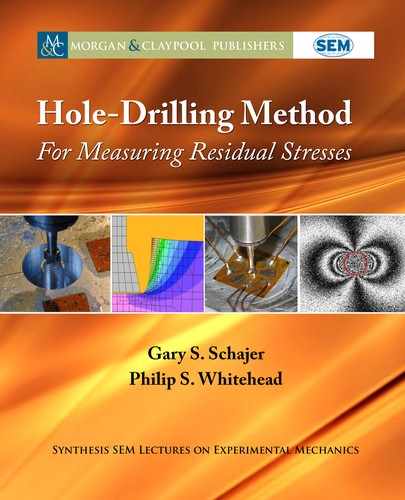
5.3. CALIBRATION CONSTANTS 93
Figure 5.3: Example 2-D finite element mesh for computing hole-drilling calibration constants.
accuracy. Contrary to occasional statements, the method does not involve any approximation
for the most common case of a linear elastic isotropic material, where the specimen is large
compared with the hole size. Only when the material is not linear elastic, for example, due to
plasticity, or it is not isotropic, or the specimen boundaries are near the hole, does a full 3-D
analysis become necessary.
e various strain gauge rosettes produced by different manufacturers are generally similar,
but vary in some details. us, their calibration constants are also similar, but are not identical.
For the most reliable stress computations, it is desirable to use the calibration constants corre-
sponding to the particular strain gauge rosette used. ese data are typically provided by the
manufacturer in graphical or numerical form or contained within computer software. Figure 5.4
shows an example graphical presentation of the calibration constants Na and
N
b for an ASTM
E837 Type A rosette. Table 3 in ASTM Standard Test Method E837-13 presents these data in
numerical form, also the data for rosette Types B and C. e presented values are for the case
where the specimen is much larger than the strain gauge rosette, with thickness greater than the
mean rosette diameter and distance to the nearest boundary at least 1.5 times the mean rosette
diameter.
e curves in Figure 5.4 show that the calibration constants vary with hole diameter and
with hole depth. e results are presented with these hole dimensions normalized relative to
the mean diameter of the strain gauge rosette. With this normalization, the strain vs. hole
depth responses become approximately proportional to the square of the hole diameter. is fea-
ture simplifies graphical presentation and subsequent interpolations between presented diameter
values.

94 5. STRESS COMPUTATIONS
0.50
0.48
0.46
0.44
0.42
0.40
0.38
0.36
0.34
0.32
0.30
0.50
0.48
0.46
0.44
0.42
0.40
0.38
0.36
0.34
0.32
0.30
0.60
0.50
0.40
0.30
0.20
0.10
0
0.30
0.25
0.20
0.15
0.10
0.05
0
D
o
/D
Z/D
D
o
/D
Coefficient
Coefficient
D
Z
Z
Gage
Gage
D
o
D
D
o
0.050 0.10 0.15 0.20 0.25
Z/D
0.050 0.10 0.15 0.20 0.25
Figure 5.4: Hole-drilling calibration constants Na and
N
b for an E837 Type A rosette (reproduced
by permission of Micro-Measurements, a Vishay Precision Group brand).
5.4 STRESS AVERAGING
Conceptually, a “uniform” residual stress measurement can be completed by measuring the strain
changes caused by drilling a hole directly to its final target depth and then using Equations (5.7)–
(5.11) with the calibration constants from Figure 5.4 or other source to determine the associated
residual stresses. ree strains are measured from the strain gauge rosette and are used to evaluate
the three in-plane components of stress. is is the original form of the Hole-Drilling Method.
However, this approach uses a minimum of data and does not take advantage of further data
that could be used.
e choice of “target” hole depth is left open to the user. Conceptually, any target depth
is acceptable providing the corresponding calibration constants are used for the residual stress
calculation. e larger hole depths close to the right sides of the graphs in Figure 5.4 are attractive
because they give larger measured strains. However, the smaller relieved strains at smaller hole
depths can also be useful as additional information. e responses at both smaller and larger
hole depths can be combined by choosing to cut the hole in a series of small depth increments
and measuring the relieved strains after each one. is provides a history of the evolution of the
relieved strains with hole depth such as shown in Figure 5.5. e residual stress calculation takes
the average of the stresses computed at each step. More reliable results are expected from the
strains measured at the larger hole depths, so it is desirable to bias the calculations toward the

5.4. STRESS AVERAGING 95
greater depth measurements. is can conveniently be done by weighting the averaging using the
calibration constant at each hole depth. e stress calculation in Equation (5.7) is then replaced
by
P D
E
.1 C /
P
. Na p/
P
. Na/
2
Q D E
P
.
N
b q/
P
.
N
b/
2
T D E
P
.
N
b t/
P
.
N
b/
2
: (5.12)
Strain 1
Strain 2
Strain 3
Regularized
Measuresd
150.
100.
50.
0.
0.00 0.20 0.40 0.60 0.80 1.00
Depth from Surface (mm)
Strains (ue)
Figure 5.5: Evolution of relieved strains measured with incremental hole drilling.
ASTM E837-13 specifies the use of 20 hole depth increments of 0.05 mm to a final depth
of 1 mm when using a 2 mm diameter hole in a 1/16” nominal Type A rosette. Deeper holes
would provide larger strains, but the Standard limits the hole depths to half a hole diameter to
reduce stress concentration effects so as to allow evaluations of residual stresses nearer the yield
stress.
Another advantage of making strain measurements over a series of hole depth increments
is that it reveals the evolution of the relieved strains. is evolution should be smooth, as in
Figure 5.5. us, if it should happen that some fault occurs during the measurement process,
it would likely create a visible anomaly in the strain vs. depth data. is eventuality could be
handled by the removal of isolated faulty data or by repetition of the entire measurement should
the fault be extensive.
Equations (5.12) are designed to be applied to the evaluation of uniform residual stresses.
However, they are sometimes applied to non-uniform stresses so as to produce a comparative
measure of their general “size.” e results are called the Equivalent Uniform Stresses (EUS),
and correspond to the uniform stress state that would produce the same response with Equa-
..................Content has been hidden....................
You can't read the all page of ebook, please click here login for view all page.
